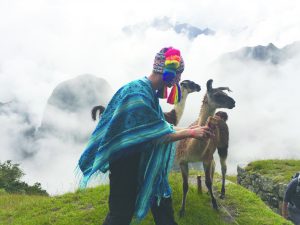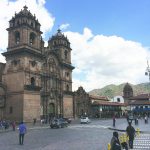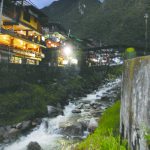By Katia Lopez Hodoyan

I never imagined I’d be inside a cloud, walking around one of the seven modern wonders of the world. The high Andes mountains seem to be breathing, but they’re not quite ready to wake up yet. The thick white fog is the mountain’s blanket and it’s not prepared to start the day off either. It’s 6:00 a.m. –the time when Machu Picchu officially opens its doors to visitors. I look at my folded map a few times to get a sense of direction, but the mist (or is it now rain?) has soaked my map. I can’t open it now, the paper has turned into mush. But who needs a map when you have an adventurous spirit and most importantly a trail? Well, it turns out, I do…
Peru’s Machu Picchu mountains don’t have one main trail, but dozens. There’s no final destination, but rather uphill mountains that seem to disappear into the unknown. There are ruins left and right, but getting to them isn’t easy. This is a hike and not a speedy one. At almost 8,000 feet above sea level, I’m surprised to see a few birds nonchalantly roaming the sky. They seem to be showing off their peaceful ritual, as if they know they have spectators enjoying the show. I wonder if they even know what altitude sickness is.
It’s so early, there’s only a hand full of tourists in sight. All of us are somewhat lost, yet too proud to admit it. We’re all roaming around aimlessly. The fog is still too thick to see far ahead, so one step at a time feels just right.
I sit down on a random rock to simply soak it all in. The air, the clouds and the stillness. I try to envision how on earth the Incas were able to build such an epic structure centuries ago without cranes or powered lifts. The determination that inevitably came when constructing it and the defeat of eventually abandoning it.
I also think of the Spanish conquistadors who thought the land was too far away, too uninhabited or insignificant to conquer. That was back in the 16th century. Years later, millions of people still find the magic in this natural setting-one of the few things that modern technology simply cannot replace. They are mountains without modern marketing tools, but they don’t need them. They are full of raw nature, history and culture. They don’t need any flashy gimmicks because they don’t have a price. The ruins don’t speak, yet they do communicate a message. They make visitors think about human potential and how much of it is often left untapped.
Time and time again I am warned about the lightheadedness one can feel in such a high altitude. I think back at what happened the night before, when I decided I would not be a victim. When I first arrived to the town of Machu Picchu, I felt a stark headache. It seems like every step was somehow bouncing off my head, vibrating with every stomp. 
As I walk through the curvy streets where merchants try to sell t-shirts and stuffed llamas to visitors, I see a woman sitting before her shop, with long black braids and a square top hat. She is selling all kinds of food and out to the side she has a basket full of coca leaves. Peruvians use them to prepare tea or sometimes they chew them directly to fight off headaches. I was planning on visiting the Machu Picchu mountains the very next day. I decide right then and there I will not experience it with a headache.
I buy a few leaves and ask the lady how I should prepare them. “Just chew them when you start to feel a headache,” she said. Come nightfall, I still have headache, so I decide to chew some seven or eight coca leaves to get rid of it. Turns out, I can’t sleep… at all. Every single sound I hear in the hotel seems louder and sharper. My eyes are wide open and my ears on point. I hear it all. A woman opening the door in the lobby, a man in the 4th floor going to the bathroom. Is that rain or is it the river that runs through the town? For the record, when I walk up and down Machu Picchu for about four hours, I notice I don’t have a headache. Even though the coca leaves provoke a sleepless night, they do get rid of the thumping sensation on the back of my head. With migraines out of the way, my sole focus is now my breath and the noise of my shoes rubbing off against the crackling bark on the floor.
Machu Picchu is much more than the typical picture one sees of a visitor before the ruins. It’s hours and hours of trekking and it’s worth every minute.
On my train back to the city of Cusco, a local guide sits next to me. My Machu Picchu experience is complete, but I still want to enjoy all the natural beauty from my seat. Every 15 minutes I stretch out my arm to take photographs. He looks at me and asks: “Did you like Peru?” I smile back as if he’s stating the obvious and say “I love it. I would like to come back.” He smirks and says: “When someone says they’d like to do something, they won’t. You have to say ‘I will do it’ for it to actually happen.” It made perfect sense. So after the three hour or so train ride, I look at him and say “I will definitely come back to Machu Picchu.”